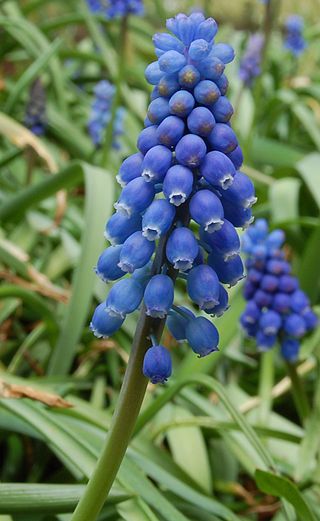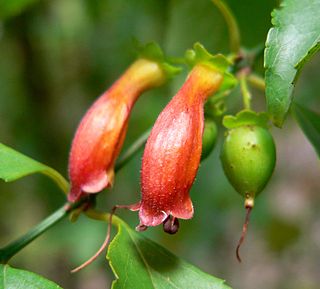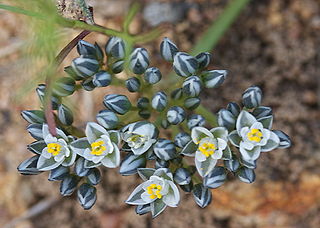
The Asclepiadoideae are a subfamily of plants in the family Apocynaceae. Formerly, they were treated as a separate family under the name Asclepiadaceae, e.g. by APG II, and known as the milkweed family.

Stapelia is a genus of low-growing, spineless, stem succulent plants, predominantly from South Africa with a few from other parts of Africa. Several Asian and Latin American species were formerly included but they have all now been transferred to other genera. The flowers of certain species, most notably Stapelia gigantea, can reach 41 cm (16 inches) in diameter when fully open. Most Stapelia flowers are visibly hairy and generate the odor of rotten flesh when they bloom.

Muscari is a genus of perennial bulbous plants native to Eurasia that produce spikes of dense, most commonly blue, urn-shaped flowers resembling bunches of grapes in the spring. The common name for the genus is grape hyacinth, but they should not be confused with hyacinths. A number of species of Muscari are used as ornamental garden plants.

Duvalia is a succulent plant genus in the subfamily Asclepiadoideae, in the family Apocynaceae (dogbane).
The genus Brachystelma is represented by over a hundred species in the world, chiefly distributed in South Africa, South-East Asia and Australasia. In India, 17 species are known to occur, of which nine are endemic.

Sagina is a genus of 20–30 species of flowering plants in the family Caryophyllaceae. These are flowering herbs native to temperate regions of the Northern Hemisphere extending south to tropical mountain areas at high altitudes, reaching just south of the equator in Africa. They are small annual or perennial herbaceous plants, growing to 5–15 cm. The leaves are opposite, often in tight whorl-like clusters, simple linear, typically 5–20 mm long. The flowers are solitary or in small cymes, with four or five green sepals and an equal number of white petals; the petal size relative to the sepal size is useful in species identification. The fruit is a small capsule containing several seeds.

Harpochloa is a genus of African plants in the grass family, common name caterpillar grass.

Halleria is a genus of flowering plants in the family Stilbaceae described as a genus by Linnaeus in 1753.

Limeum is a genus of flowering plants. It includes 25 species.

Hessea is a genus of bulb-forming plants in the Amaryllis family native to Namibia and South Africa. The genus name commemorates C. H. F. Hesse (1772–1832), who resided in Cape Town from 1800 to 1817.

Tromotriche is a genus of plant in family Apocynaceae. It is native to southern Africa.

Tavaresia is a genus of plants in the family Apocynaceae, first described as a genus in 1902. It is native to southern Africa.
- Tavaresia angolensisWelw. - Angola
- Tavaresia barklyi(Dyer) N.E.Br. - South Africa
- Tavaresia grandifloraBerger - South Africa
- Tavaresia meintjesiiR.A. Dyer - Limpopo

Stenostelma is a genus of plants in the family Apocynaceae, first described as a genus in 1894. It is native to southern Africa, ranging from Mozambique, Zambia, and Namibia to South Africa.

Riocreuxia is a plant genus in the family Apocynaceae, and named in honour of the botanical illustrator Alfred Riocreux (1820-1912). It was first described as a genus in 1844 and is native to Africa.
Pectinaria is a genus of plants in the family Apocynaceae, first described as a genus in 1819. The entire genus is endemic to South Africa.
Periglossum is a genus of flowering plants in the family Apocynaceae, first described as a genus in 1844. It is native to southern Africa.
- Periglossum angustifoliumDC. - South Africa
- Periglossum kassnerianumSchltr. - South Africa
- Periglossum mackeniiHarv. - South Africa
- Periglossum macrumDecne. - South Africa
- Periglossum mossambicenseSchltr. - Mozambique

Ischnolepis natalensis is a climbing geophyte vine, commonly known as propeller vine, in the dogbane family, Apocynaceae. It is native to Eastern Cape and KwaZulu-Natal provinces of South Africa.
Hypertelis is a genus of flowering plants in the family Molluginaceae. Most of its former species have been transferred to the new genus Kewa, and the remaining species, Hypertelis spergulacea, may also need a different placement. Hypertelis spergulacea is a woody-based plant, up to 30 cm (1 ft) high, with whorled greyish green leaves. It is found on the border between Namibia and the Northern Cape province of South Africa.














